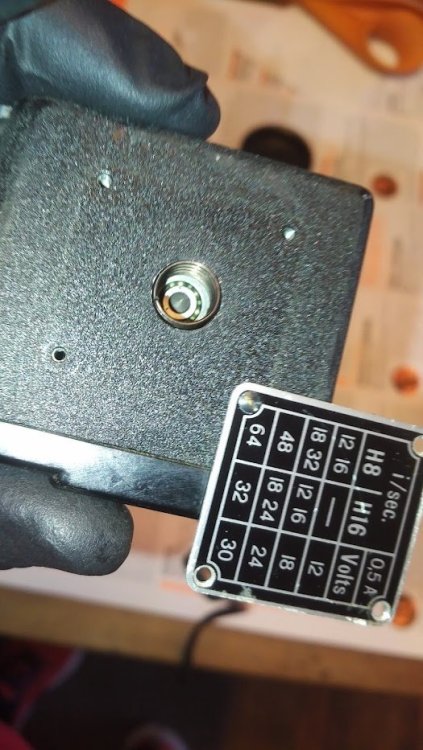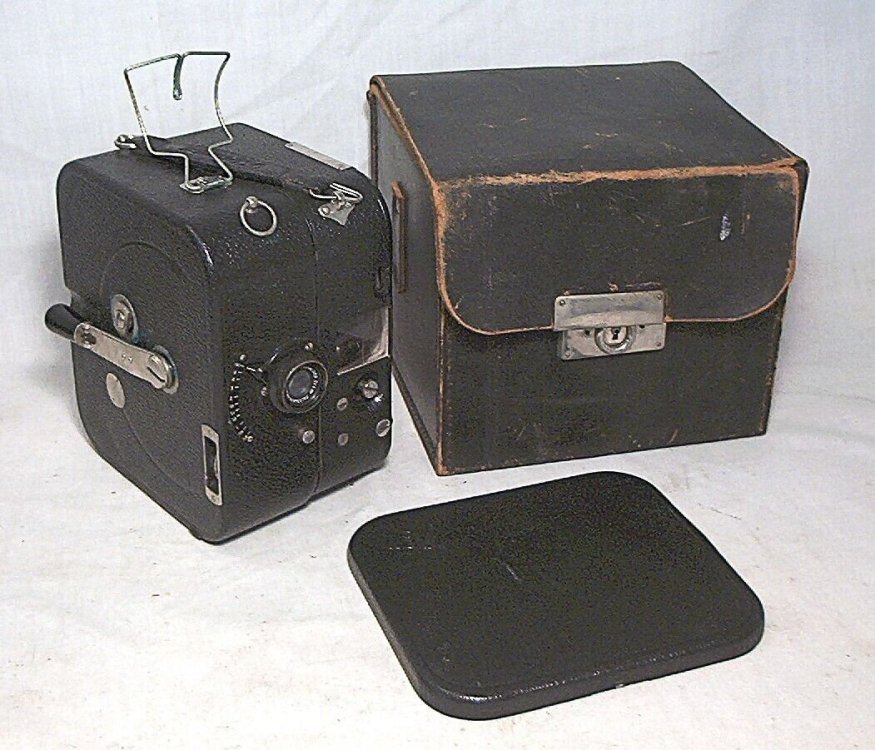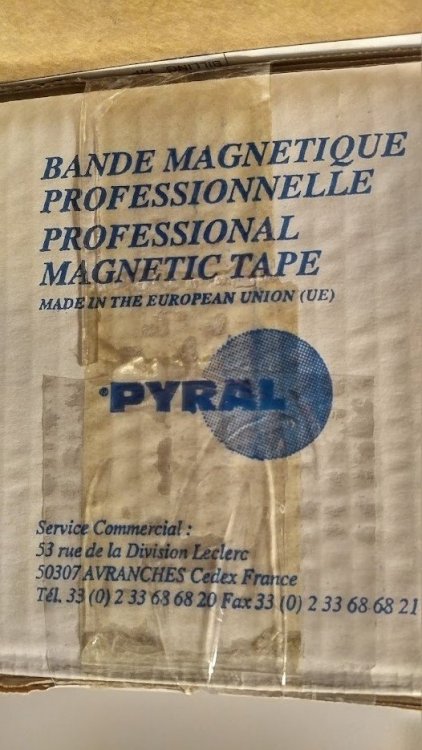-
Posts
18 -
Joined
-
Last visited
Profile Information
-
Occupation
Cinematographer
-
Location
Massachusetts
Contact Methods
-
Website URL
https://www.davidbendiksen.com/portfolio
Recent Profile Visitors
2,752 profile views
-
David Bendiksen started following OPTICS UPGRADE for Bolex REX 6X to 10X-PLUS Viewfinder , 1:8 Shaft With Sheared Off Pin... , Using a Kinamo 35mm and 3 others
-
Bill, I wanted to say 'thank you' for posting these photos. I had 3 of these M-17 motors that I wanted to be sure were in good shape before I sent them out with students, and your post gave me enough courage to open them. Real easy. In addition to lubricating the worm gear and putting a dab of grease in that end cup that acts as a bearing, I also wanted to note for posterity: under the i/sec reference plate you can access the bearing on the tiny other end of the worm gear and give it a little oil. And for the curious, there is very little under the plastic switch cover except the switch itself and this capacitor. If I'm reading the color bands correctly (brown/green/yellow/white/red?), then it would be .15µF +-10%, 250V max. Someone let me know if that's incorrect and I'll edit this for reference.
-
Glad to find this thread, very helpful info! I just won the Kinamo (mis-listed as "Kimano") that ended today. Doesn't come with a cassette, so I'm going to have to figure that out...
-
If you can believe it, we still cut on mag stock where I teach at both Emerson College and the University of Massachusetts Amherst, so that the students get an immersive editing experience on the Steenbeck. Emerson has a stash, but we could really use some at UMass. IF any of you have 16mm fullcoat -- 3 or 5mil, acetate or polyester, since beggars can't be choosers, though we have our mag dubber optimized right now for 5mil -- I'd gladly pay shipping to put it to good use, just send me a message. The last (and only) post I can find here about Pyral stock was from 15 years ago!
-
We did it! And I made it back home safely. 1000 miles, just about 17 hours driving round-trip. Attached are a couple cell phone pics (sorry for the low res) of how we got it in. We were just careful, moved slow, and it was really no trouble at all, one of us on each end of it. Three elements greatly eased the process: 1) Before I arrived the former owner removed the screen, the speaker+mount, and part of the top before we got there, allowed us to roll just the mainframe through the front door on its casters which were in good shape (had to pull off the door) 2) Motorcycle/atv/etc ramp kit. They're two Z-shaped 750lb-rated aluminum pieces that you bolt to the end of the longest board you can bring to make a ramp. I got mine for something like $25 and used them to load a 500lb 90s Honda Shadow into a truck back in 2015, so I knew it could take the weight. Here's a link to a nice set: https://www.homedepot.com/p/Erickson-12-in-x-12-in-Aluminum-Ramp-Plates-Kit-07300/312522399 3) For $5-10 when it goes on sale, pick up a 4-pack of ratcheting tie down straps from Horror Fright (https://www.harborfreight.com/400-lb-capacity-1-in-x-15-ft-ratcheting-tie-downs-4-pk-63094.html) or similar. We looped these around the legs/frame and anchored them into the very convenient steel lugs in the floor of my Chrysler Town & Country where the seats normally attach (they fold down and stow away leaving these anchor points free). Then we used bubble wrap and sheets of cardboard to protect things during transit. I stopped at several points on the drive home to see if anything needed tightening but the Steenbeck didn't shift at all. No trouble at all going through customs at the border, either -- Mark, in answer to your question, I brought a printout of some completed eBay listing I'd saved in the past few years to show similar valuation under $2500 (especially in its "as is" state...), and combined with a simple write-up on letterhead saying it was being donated rather than purchased, it didn't take more than two minutes of waiting for them to send me on through. A huge thank you to everyone in this thread who offered precautions and advice! Now comes the fun of getting it cleaned up and refurbished because boy is it going to need it, so I'll make periodic updates in a new post as that gets underway. It's an ST900W at one time owned by CBC Canada. First order of business: it smells *strongly* of cat urine and smoke. My solution: get a bottle of Ozium from the auto parts store. I swear by this stuff -- cheaper than an ozone generator if you just have one or two projects. Sprayed half a can into the car when I got home, closed it up to sit and dissipate, and it's already much better after a few hours.
-
Update for posterity: called CBP, they instructed me to call the specific border crossing station, which I did; they rerouted me to a line for customs questions, where the agent there replied that since the valuation is under $2500, I don't need to fill out a form, but that bringing something on letterhead saying it's being donated would be a good move, along with a printout of something like the price sheet from Cutfilm to show valuation. Wish me luck tomorrow! And if anyone's in Toronto and could lend a hand with the heavy lifting, shoot me a message since we could certainly use the help. Thanks everyone.
-
Thank you Mark for such great resources, and thank you Robert for the further advice on the loading. Eric, you're right -- I should just call and ask, but I'm also grateful for your similar scenario about the golf equipment; that's pretty much the kind of anecdote I was hoping to hear. And I totally agree: Alexander Keith's is great. My wife and I and some friends who have family up in Nova Scotia took a tour of their brewery a few years back.
-
Thanks Mark -- will definitely be in touch if I find anything toasty or untoward once this thing is at it's new home. I've recapped vintage audio equipment before and do have a power conditioner and Variac. I appreciate the heads up that they might be needed. Dwight has been very kind on the phone this past year when I've called in to work out logistics. He was of course thrilled to hear anywhere was getting their analog film program back in gear. He services Hampshire's 6-plate units nearby as well, so once we scrounge the funds we're definitely having him come do maintenance.
-
Wow, thanks for such a generously detailed write-up, Robert. Sounds like tape, cardboard, and plenty of care are requisite things for me to take on the trip. Dennis, thanks for the warning on Sarnia -- fortunately I'm not bringing any film with me, just lugging back the deck. Hoping someone will be able to chime in with regard to magic words I should say (or avoid) when bringing it back through customs.
-
This coming weekend I'll be picking up a Steenbeck 6-plate in Toronto and driving it back to Amherst MA in a van, 8hrs each way. Thanks to a fantastic thread from a few years ago (https://cinematography.com/index.php?/forums/topic/77517-help-dismantling-a-steenbeck-for-moving/) I feel more prepared with good advice on how to go about the physical moving itself, but I'm hoping to tap into the well of knowledge/experience on the issue of bringing a piece of equipment like this back through customs. What should I expect? Will I owe import fees? Couldn't quite decide whether this question more appropriately belonged under "Editing" or "General Discussion," but since it might be answered by someone who's brought back a similar piece of hardware, I figured I'd put it here. If it helps, no money is exchanging hands -- it's being donated to our university program by a very kind guy. But I don't actually know if that's pertinent in terms of coming back into the country with goods I didn't enter with. I can draw up something on university letterhead stating as much; or if need be, I can hand the guy a buck and state that it was sold for $1 to override potential overvaluation, etc. Of course, if anyone state-side within about the same drive happens to have a spare Steenbeck and feels like saving me the trip... send me a message!
-

OPTICS UPGRADE for Bolex REX 6X to 10X-PLUS Viewfinder
David Bendiksen replied to Arthur Sanchez's topic in Cine Marketplace
Hi Arthur -- just wanted to write that this is still on my mind and project list. I spent an hour today with a kind optician on our campus (finally, some benefit to the humanities from teaching at a full-blown research institution!) pulling out an Octameter's lens elements and figuring out their diopter power on a Bausch & Lomb lensometer. It was a fruitful investigation but teaching has me extremely busy so I may have to shelve this 'til the Spring semester. -

Looking to buy Rivas or Hollywood 16mm tape splicer
David Bendiksen replied to Derick Crucius's topic in Cine Marketplace
Derick, did you find one yet? I much prefer the Italian-style perforating splicers but understand your situation. I see a very affordable, poorly listed Hollywood splicer on fleaBay right now (not my listing -- it was hard to find through a search but that seems to have kept the price down) and will send you a link in a message. Good luck! -

OPTICS UPGRADE for Bolex REX 6X to 10X-PLUS Viewfinder
David Bendiksen replied to Arthur Sanchez's topic in Cine Marketplace
Hi Arthur -- I've seen your work and posts before in the Film Camera Repair Directory too, wonderful stuff! Can you share the details on how you worked this magic? I'm assuming you added a diopter into the finder? I'd bookmarked at least one other person trying something like this from Jan-Eric Nyström's now-defunct page on hand-modifying Bolexes to Super 16. He hot glues a small lens in place inside: https://web.archive.org/web/20120123185702/http://www.sci.fi/~animato/s16/s16.html I have to CLA a bunch of ancient Bolexes over this summer before our students use them in the Fall, and a lot of the ones we have are equipped with rather ancient finders (especially the non-reflex ones...) that could really benefit from some more magnification. The other idea I've been playing with is just to attach a cheap viewfinder magnifier -- less than $5 apiece straight from China, and with an eyecup attached to boot! Though the one at the link below may be way too much magnification (2.8x): https://www.ebay.com/itm/2-8X-3-V1-LCD-Viewfinder-Eyecup-Magnifier-Extender-Hood-for-Canon-5D-II-7D/293071188759 -
Robert, very kind of you to chime in from over at Cinelab! I'm sure you know Abraham's workshop from Hampshire quite well -- I try to keep in touch with him pretty closely, and you guys have been the backbone of black & white 16mm across the Five Colleges for years. I didn't even realize until recently that someone's running a 16mm course over at Amherst College as well (a visiting assistant professor, I believe). Once I get all our ducks in a row in terms of cameras and editing equipment (I have a lot of CLAing to do...) I would really look forward to giving you a call to chat about our future processing needs. Yes, our Filmline processor has sat for awhile by now and certainly has some frozen bearings as you mention, but I do wish I could see it and our lab space utilized. It's just sitting there, cemented into the floor in the old power plant building which isn't really a good space for classrooms or anything else. Perhaps we can convince UMass administration into giving you the use of it for Cinelab's Minilab 2.0 ?
-
Thanks for the encouragement, Bruce -- Cine Lab is indeed who we'd be sending out to. Never had a problem or delay with them except a couple years back (maybe 2014) when they were overhauling a bunch of equipment. And yes, shooting silent is pretty much the only way we can run it (I'm not quite crazy enough to hand out Nagras in 2019...). You've also guessed correctly that having students get their camera original processed reversal is the most cost-effective way to do things if far from optimal -- I know that's how Hampshire College has been doing it for years since Cinelab will do this at their student rate of .22c/ft. Combined with Kodak's current 30% student discount for 100ft of fresh Tri-X, that adds up to $50+ per roll, which by the end of the semester probably costs each student around what textbooks for any other 400-level course would cost anyway.
-
Tyler, thanks so much for your detailed reply. Fabulous website -- I completely agree with what you write there that "It starts with a lot of passion." I'm impressed both by your commitment to teaching students first-hand just how superb film can still be and by your resolve in making that process a viable business model in the present day and age. Not too negative at all -- most of your reply is just being realistic! At least from my experience across the Five Colleges, I would say that running 16mm courses in black-and-white and offering hand processing as a creative tool in addition to lab sendout hasn't hampered student interest at all. Sure, if we had the money and resources, we'd show them just what "4k scans and a crisp/clean image" can look like too, but we've got to work with what we have, and enrollment is through the roof even with just the rudimentary options. They've been running 16mm production courses at Hampshire and Amherst College this way for years and student interest also continues to be strong. I know nearly nowhere runs "all film" programs anymore, but I'm still interested in what colleges/universities are still offering 16mm production of some sort. From applying to jobs in the past year I'm fairly certain that Ithaca College, Keene State, Grinnell, and Denison are active. Can anyone else chime in with more?












